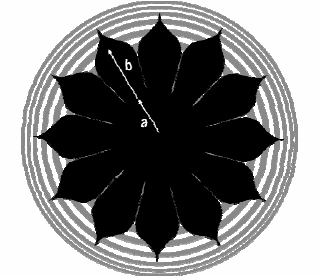
[ Coronagraphs and Occulters ] [ Diffraction ] [ Optics ]
![]()
The New Worlds Observer starshade utilizes a breakthrough petal shape to suppress diffraction. In the past, various occulter shapes have been considered for planet detecting missions, but none of them have been viable solutions because diffraction and scatter around the occulter have limited the suppression of starlight. The petal shaped starshade allows for enough planet-star contrast for the planets to be detectable.
A starshade good enough for planet detection must be designed in such a way that the light from all paths through and around the shade is extremely close to zero. A 2003 study has shown that it is possible to suppress diffraction over a broad spectral band to the 10 -10 level even while being very close to the star. 1 By numerically integrating the Fresnel diffraction equations and subsequent mathematical derivation, Webster Cash has discovered a new class of apodization functions that enable a high level of diffraction control for occulters – so high, in fact, that the suppression factors achieved are many orders of magnitude better than predecessor designs of any given size. 2 These functions are given by:
a(ρ) = 0 for ρ < a
a(ρ) = 1-exp(-[(ρ-a)/b] n) ρ > a
a is the radius of the central disk. The petals extend outward from this radius and rise to 1-e -1 to a radius of a + b. The amount of diffraction in the center of the shadow is given by:
R = (n!) 2(λF/2πab) 2n
λ is the wavelength and F is the distance between the occulter and the telescope.
The design extinguishes Poisson's spot, a central bright spot caused by diffraction that has plagued previous occulter designs. For shorter wavelengths, the deep zone of the star shadow created is 10-20 m in diameter, creating an area wide enough to place a telescope. The center of the shadow is extremely dark from 0.4 to 1.1 μm.
 |
A 12 petal starshade. The gray areas represent Fresnel zones. |
References:
1 Kasdin N, Vanderbei R, Spergal R, and Littman M (2003) Extrasolar planet finding via optical apodized and shaped pupil coronagraphs. Astrophys. J. 582, 1147-1161.
2 Cash, Webster (2006) Detection of Earth-like planets around nearby stars using a petal shaped occulter. Nature 442, 51-53.